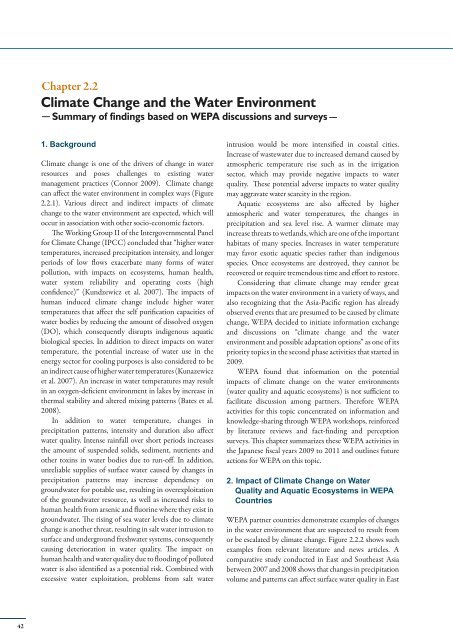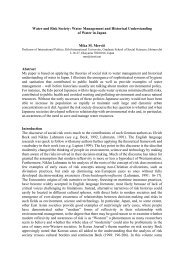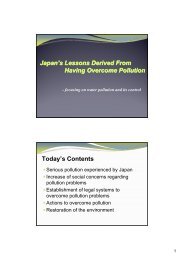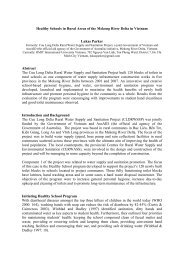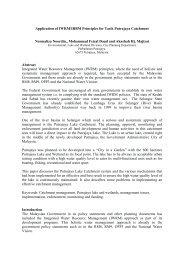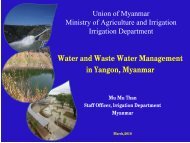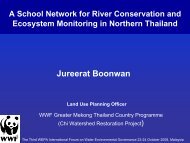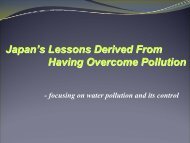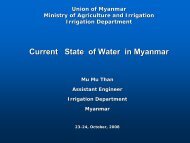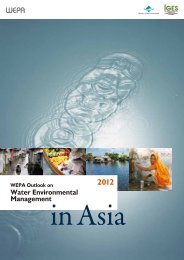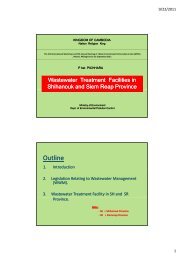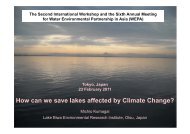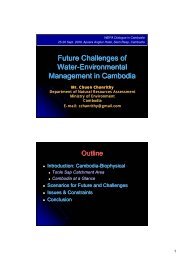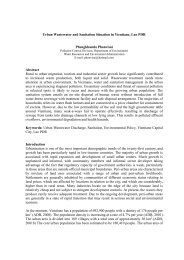WEPA Outlook on Water Environmental Management in Asia 2012
WEPA Outlook on Water Environmental Management in Asia 2012
WEPA Outlook on Water Environmental Management in Asia 2012
Create successful ePaper yourself
Turn your PDF publications into a flip-book with our unique Google optimized e-Paper software.
Chapter 2.2Climate Change and the <strong>Water</strong> Envir<strong>on</strong>mentSummary of f<strong>in</strong>d<strong>in</strong>gs based <strong>on</strong> <str<strong>on</strong>g>WEPA</str<strong>on</strong>g> discussi<strong>on</strong>s and surveys1. BackgroundClimate change is <strong>on</strong>e of the drivers of change <strong>in</strong> waterresources and poses challenges to exist<strong>in</strong>g watermanagement practices (C<strong>on</strong>nor 2009). Climate changecan affect the water envir<strong>on</strong>ment <strong>in</strong> complex ways (Figure2.2.1). Various direct and <strong>in</strong>direct impacts of climatechange to the water envir<strong>on</strong>ment are expected, which willoccur <strong>in</strong> associati<strong>on</strong> with other socio-ec<strong>on</strong>omic factors.The Work<strong>in</strong>g Group II of the Intergovernmental Panelfor Climate Change (IPCC) c<strong>on</strong>cluded that “higher watertemperatures, <strong>in</strong>creased precipitati<strong>on</strong> <strong>in</strong>tensity, and l<strong>on</strong>gerperiods of low flows exacerbate many forms of waterpolluti<strong>on</strong>, with impacts <strong>on</strong> ecosystems, human health,water system reliability and operat<strong>in</strong>g costs (highc<strong>on</strong>fidence)” (Kundzewicz et al. 2007). The impacts ofhuman <strong>in</strong>duced climate change <strong>in</strong>clude higher watertemperatures that affect the self purificati<strong>on</strong> capacities ofwater bodies by reduc<strong>in</strong>g the amount of dissolved oxygen(DO), which c<strong>on</strong>sequently disrupts <strong>in</strong>digenous aquaticbiological species. In additi<strong>on</strong> to direct impacts <strong>on</strong> watertemperature, the potential <strong>in</strong>crease of water use <strong>in</strong> theenergy sector for cool<strong>in</strong>g purposes is also c<strong>on</strong>sidered to bean <strong>in</strong>direct cause of higher water temperatures (Kunazewiczet al. 2007). An <strong>in</strong>crease <strong>in</strong> water temperatures may result<strong>in</strong> an oxygen-deficient envir<strong>on</strong>ment <strong>in</strong> lakes by <strong>in</strong>crease <strong>in</strong>thermal stability and altered mix<strong>in</strong>g patterns (Bates et al.2008).In additi<strong>on</strong> to water temperature, changes <strong>in</strong>precipitati<strong>on</strong> patterns, <strong>in</strong>tensity and durati<strong>on</strong> also affectwater quality. Intense ra<strong>in</strong>fall over short periods <strong>in</strong>creasesthe amount of suspended solids, sediment, nutrients andother tox<strong>in</strong>s <strong>in</strong> water bodies due to run-off. In additi<strong>on</strong>,unreliable supplies of surface water caused by changes <strong>in</strong>precipitati<strong>on</strong> patterns may <strong>in</strong>crease dependency <strong>on</strong>groundwater for potable use, result<strong>in</strong>g <strong>in</strong> overexploitati<strong>on</strong>of the groundwater resource, as well as <strong>in</strong>creased risks tohuman health from arsenic and fluor<strong>in</strong>e where they exist <strong>in</strong>groundwater. The ris<strong>in</strong>g of sea water levels due to climatechange is another threat, result<strong>in</strong>g <strong>in</strong> salt water <strong>in</strong>trusi<strong>on</strong> tosurface and underground freshwater systems, c<strong>on</strong>sequentlycaus<strong>in</strong>g deteriorati<strong>on</strong> <strong>in</strong> water quality. The impact <strong>on</strong>human health and water quality due to flood<strong>in</strong>g of pollutedwater is also identified as a potential risk. Comb<strong>in</strong>ed withexcessive water exploitati<strong>on</strong>, problems from salt water<strong>in</strong>trusi<strong>on</strong> would be more <strong>in</strong>tensified <strong>in</strong> coastal cities.Increase of wastewater due to <strong>in</strong>creased demand caused byatmospheric temperature rise such as <strong>in</strong> the irrigati<strong>on</strong>sector, which may provide negative impacts to waterquality. These potential adverse impacts to water qualitymay aggravate water scarcity <strong>in</strong> the regi<strong>on</strong>.Aquatic ecosystems are also affected by higheratmospheric and water temperatures, the changes <strong>in</strong>precipitati<strong>on</strong> and sea level rise. A warmer climate may<strong>in</strong>crease threats to wetlands, which are <strong>on</strong>e of the importanthabitats of many species. Increases <strong>in</strong> water temperaturemay favor exotic aquatic species rather than <strong>in</strong>digenousspecies. Once ecosystems are destroyed, they cannot berecovered or require tremendous time and effort to restore.C<strong>on</strong>sider<strong>in</strong>g that climate change may render greatimpacts <strong>on</strong> the water envir<strong>on</strong>ment <strong>in</strong> a variety of ways, andalso recogniz<strong>in</strong>g that the <strong>Asia</strong>-Pacific regi<strong>on</strong> has alreadyobserved events that are presumed to be caused by climatechange, <str<strong>on</strong>g>WEPA</str<strong>on</strong>g> decided to <strong>in</strong>itiate <strong>in</strong>formati<strong>on</strong> exchangeand discussi<strong>on</strong>s <strong>on</strong> “climate change and the waterenvir<strong>on</strong>ment and possible adaptati<strong>on</strong> opti<strong>on</strong>s” as <strong>on</strong>e of itspriority topics <strong>in</strong> the sec<strong>on</strong>d phase activities that started <strong>in</strong>2009.<str<strong>on</strong>g>WEPA</str<strong>on</strong>g> found that <strong>in</strong>formati<strong>on</strong> <strong>on</strong> the potentialimpacts of climate change <strong>on</strong> the water envir<strong>on</strong>ments(water quality and aquatic ecosystems) is not sufficient tofacilitate discussi<strong>on</strong> am<strong>on</strong>g partners. Therefore <str<strong>on</strong>g>WEPA</str<strong>on</strong>g>activities for this topic c<strong>on</strong>centrated <strong>on</strong> <strong>in</strong>formati<strong>on</strong> andknowledge-shar<strong>in</strong>g through <str<strong>on</strong>g>WEPA</str<strong>on</strong>g> workshops, re<strong>in</strong>forcedby literature reviews and fact-f<strong>in</strong>d<strong>in</strong>g and percepti<strong>on</strong>surveys. This chapter summarizes these <str<strong>on</strong>g>WEPA</str<strong>on</strong>g> activities <strong>in</strong>the Japanese fiscal years 2009 to 2011 and outl<strong>in</strong>es futureacti<strong>on</strong>s for <str<strong>on</strong>g>WEPA</str<strong>on</strong>g> <strong>on</strong> this topic.2. Impact of Climate Change <strong>on</strong> <strong>Water</strong>Quality and Aquatic Ecosystems <strong>in</strong> <str<strong>on</strong>g>WEPA</str<strong>on</strong>g>Countries<str<strong>on</strong>g>WEPA</str<strong>on</strong>g> partner countries dem<strong>on</strong>strate examples of changes<strong>in</strong> the water envir<strong>on</strong>ment that are suspected to result fromor be escalated by climate change. Figure 2.2.2 shows suchexamples from relevant literature and news articles. Acomparative study c<strong>on</strong>ducted <strong>in</strong> East and Southeast <strong>Asia</strong>between 2007 and 2008 shows that changes <strong>in</strong> precipitati<strong>on</strong>volume and patterns can affect surface water quality <strong>in</strong> East42


